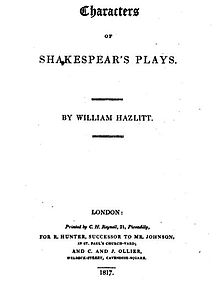This article may be too long to read and navigate comfortably. When this tag was added, its readable prose size was 18,000 words. (April 2024) |
 Title page of Characters of Shakespear's Plays 1st edition | |
| Author | William Hazlitt |
|---|---|
| Language | English |
| Genre | Literary criticism |
| Publisher | Rowland Hunter with Charles and James Ollier |
Publication date | 9 July 1817 |
| Publication place | England |
| Media type | |
| Preceded by | The Round Table |
| Followed by | A View of the English Stage |
Characters of Shakespear's Plays is an 1817 book of criticism of Shakespeare's plays, written by early nineteenth century English essayist and literary critic William Hazlitt. Composed in reaction to the neoclassical approach to Shakespeare's plays typified by Samuel Johnson, it was among the first English-language studies of Shakespeare's plays to follow the manner of German critic August Wilhelm Schlegel, and, with the work of Samuel Taylor Coleridge, paved the way for the increased appreciation of Shakespeare's genius that was characteristic of later nineteenth-century criticism. It was also the first book to cover all of Shakespeare's plays, intended as a guide for the general reader.
Then becoming known as a theatre critic, Hazlitt had been focusing increasingly on drama as literature, contributing miscellaneous literary criticism to various journals, including the prestigious Edinburgh Review. This was the first of his book-length literary studies. The plays, the thirty-five that Hazlitt considered to be genuine, are covered in thirty-two chapters, with new material added to passages reworked from periodical articles and reviews. A Preface establishes his main theme of the uniqueness of Shakespeare's characters and looks back at earlier Shakespearean criticism. Two concluding chapters on "Doubtful Plays of Shakespear" and the "Poems and Sonnets" round out the book.
The centre of attention is in large part on the characters, described often with a personal slant and using memorable expressions ("It is we who are Hamlet") and incorporating psychological insights that were to become highly influential in later criticism. Though at first less influential, Hazlitt's comments on the plays' dramatic structure and poetry and on the central themes and general mood of each play laid the groundwork for later critics' more elaborate interpretations. Frequently expressing the view that stage presentation could not do justice to Shakespeare's plays, Hazlitt nevertheless also found certain plays eminently actable, and he frequently admired the performances of certain actors, particularly Edmund Kean.
At first highly acclaimed—it made an immediate and powerful impact on the poet John Keats, among others—then brutally criticised, Hazlitt's book lost much of its influence in the author's lifetime, only to re-enter the mainstream of Shakespearean criticism in the late nineteenth century. The first edition sold out quickly; sales of the second, in mid-1818, were at first brisk, but they ceased entirely in the wake of harshly antagonistic, personally directed, politically motivated reviews in the Tory literary magazines of the day. Although some interest continued to be shown in Hazlitt's work as an essayist, it was not until the end of the nineteenth century, long after Hazlitt's death, that significant interest was again shown in his interpretations of Shakespeare. In the twentieth century, the influential critic A.C. Bradley and a few others began to take seriously the book's interpretations of many of Shakespeare's characters. But then Hazlitt along with Bradley was censured for displaying faults of the "character" school of Shakespearean criticism, primarily that of discussing dramatic characters as though they were real people, and again Hazlitt's contributions to Shakespearean criticism were deprecated.
A revival of interest in Hazlitt, as a thinker, began in the mid-20th century. His thoughts on Shakespeare's plays as a whole (particularly the tragedies), his discussions of certain characters such as Shylock, Falstaff, Imogen, Caliban and Iago and his ideas about the nature of drama and poetry in general, such as expressed in the essay on Coriolanus, gained renewed appreciation and influenced other Shakespearean criticism.
Hazlitt's ideas about many of the plays have now come to be valued as thought-provoking alternatives to those of his contemporary Coleridge, and Characters of Shakespear's Plays is now viewed as a major study of Shakespeare's plays, placing Hazlitt with Schlegel and Coleridge as one of the three most notable Shakespearean critics of the Romantic period.
